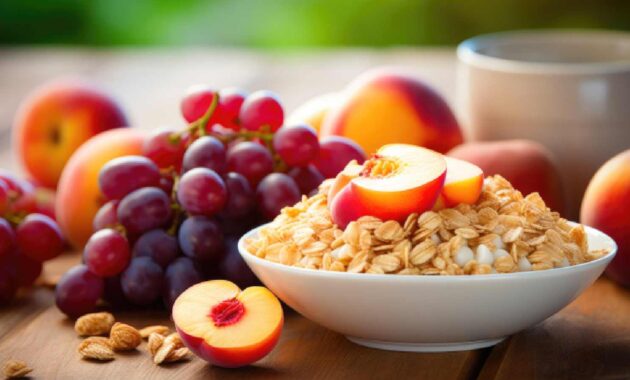In the world of nutrition, one component stands out for its unique qualities—fiber. Getting just the right amount of fiber is important for good health. It’s a type of carbohydrate that the human body cannot fully digest, but its importance in our diet cannot be overstated. For some people, it helps in fighting constipation and can aid in weight loss and further helping maintain the weight loss. It is also known to lower cholesterol levels and reduce the risk of diabetes or heart disease. Even after knowing its importance, most people aren’t getting ample fiber from their diet. As per recommendation, women should aim to get 25 grams of fiber, while men should aim for 38 grams of fiber daily.
Health Shots got in touch with Suvidhi Jain, Lifestyle, Exercise and Nutrition Coach & Founder – LEAN by Suvidhi, to understand ways to eat more fiber through your everyday diet.

Why fiber is important for your body?
Fiber plays a crucial role in promoting overall well-being, and here’s why.
1. Facilitating electrolyte absorption
“Fiber may not be a nutrient powerhouse, but it’s a master at facilitating nutrient absorption. Among its many talents, fiber aids in the absorption of essential electrolytes, ensuring that your body maintains the right balance of minerals needed for optimal function,” says the expert.
2. Taming inflammation
Inflammation is at the root of many health issues, from chronic diseases to minor discomforts. Fiber steps in as a natural anti-inflammatory agent, helping to reduce inflammation throughout the body and potentially lowering the risk of various health problems.
3. Regulating sugar absorption
“For those looking to stabilize blood sugar levels, fiber is a trusted ally. By regulating the absorption of sugar in the bloodstream, it helps prevent sharp spikes and crashes, making it an essential component of a diabetes-friendly diet,” tells the expert.
4. Enhancing insulin sensitivity
Fiber’s influence doesn’t stop at sugar control. It also contributes to improved insulin sensitivity, a critical factor in managing diabetes and maintaining overall metabolic health.
Select Topics of your interest and let us customize your feed.
PERSONALISE NOW
5. Boosting digestion and appetite control
The expert says, “Incorporating more fiber into your daily meals can improve the functioning of your digestive system. It promotes healthy digestion, aids in appetite control, and contributes to an overall sense of satiety, making it easier to manage your weight”.
6. The body’s natural scrubber
Think of fiber as your body’s natural scrubber. As it passes through your digestive tract, it adds bulk to stool without being digested itself. This not only eases constipation but also cleanses the gastrointestinal system as it exits the body.
Also read: Fibre: Why do you need this nutrient in your daily diet?
Ways to incorporate more fiber in your diet
Now that we’ve explored the benefits and types of fiber, here are some practical steps on how to eat more fiber and enhance your diet’s nutritional value:
1. Swap white rice for brown rice
The expert suggests, “Make the simple switch from refined white rice to nutrient-packed brown rice to increase fiber intake while enjoying a heartier grain”.

2. Opt for whole grains over refined flour
Replace processed maida with whole grains in your cooking and baking. This change not only boosts fiber but also provides a broader spectrum of nutrients.
3. Choose fruits over sweets
“Satiate your sweet tooth cravings by replacing sugary desserts with naturally sweet fruits. They’re not only delicious but also rich in fiber, vitamins, and minerals,” says the expert.
4. Embrace green vegetables
Incorporate green vegetables into your diet, whether as side dishes, salads, or freshly squeezed veggie juices. They’re a fantastic source of both soluble and insoluble fiber. Check out some of the best fiber-rich foods!
5. Trade oils for nuts
When cooking or snacking, consider reducing your oil intake and incorporating nuts as a source of healthy fats and additional fiber.
6. Experiment with legumes
Legumes like beans, lentils, and chickpeas are the best sources of fiber. Use them in soups, stews, salads, and as meat substitutes in dishes like veggie burgers and tacos.
7. Enjoy fiber-packed smoothies
Add fruits like bananas, berries, or avocado, and a handful of spinach or kale to your morning smoothie. These ingredients are rich in fiber and will give your smoothie a nutritious boost.
8. Incorporate chia seeds and flaxseeds
Sprinkle chia seeds or ground flaxseeds on top of yoghurt, oatmeal, or in your smoothies. These seeds are rich in fiber and also provide essential omega-3 fatty acids.
9. Add fiber supplements
If you find it challenging to meet your fiber needs through food alone, consider adding a fiber supplement like psyllium husk or a prebiotic fiber supplement to your routine. Don’t forget to get in touch with a healthcare professional before starting any supplement regimen.
Incorporating these dietary changes can lead to a healthier, more fiber-rich diet, promoting better digestion, lower inflammation, and improved overall health. Fiber may not be fully digestible, but its impact on your well-being is unquestionably substantial.
#eat #fiber #day
